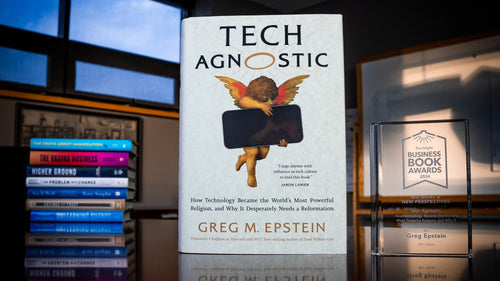Leading Clarity: The Breakthrough Strategy to Unleash People, Profit, and Performance

If you have worked in the professional world for longer than, say, six months, you will have inevitably sat through one or two or three hundred brainstorming meetings with the sole purpose of "thinking outside the box." The philosophy, popularized by the "nine-dot problem," urges us to throw off every constraint of past procedures, philosophies, and limitations to break brand new ground. To solve the puzzle, we must look beyond the implied box around the nine dots on the paper, and see a vast world of potential that awaits us, if we can only change the way our brain translates these implied parameters. But what if the box isn't the problem, but rather part of the solution? What if those limitations are the very thing that will generate the new ideas? What if we need to start thinking inside the box instead? The first chapter from Brad Deuster's Leading Clarity: The Breakthrough Strategy to Unleash People, Profit, and Performance turns this well-worn phrase on its head.
Think Inside the Box
The concept of “thinking outside the box” has been the go-to, we’re-all-about-it superstar for decades. TED Talks offer up a chorus of praise for this invocation to innovation, certain to bring greater success to businesses and organizations. Proponents say thinking outside the box fires up creativity and that it can result in inventive solutions to an organization’s most nagging problems. But for all the positive promotion it’s received over the years, that philosophy may be putting too much emphasis on the wrong side of the box.
I believe, and our work has found, that you have a much better chance of success if you understand the parameters you’re working within as an organization, and then see if you can stretch the box to meet your goals and vision. In other words, taking into account real-world limitations—such as budget constraints, industry regulations, looming deadlines—can actually help to spark creativity by keeping it focused rather than using an open-ended, anything-goes approach that doesn’t reliably result in ideas that can be implemented from a practical standpoint.
The Pitfalls Of Trying To Think Outside The Box
Thinking outside the box sounds like a great way to spur creativity and innovation, but it can take you in directions far removed from your true goals or what you can actually accomplish. We find it to have ambiguity in that there are no boundaries, there are too many variables, and too many unknowns. When working in the box, your playing field is more defined and there is greater understanding of specifics and their possible impact on your desired outcome.
Furthermore, the box provides a critical context for the board and leader to work together and create commonality around the expectations of the company. The box provides a form of clarity for all to grab hold of and work toward. The powerful point is that the box is of your own making.
While society celebrates wild, outside-the-box ideas, even though most of us don’t have the creativity or vision to really be far outside, the complexity of today’s business environment dictates that you must be more focused, more purposeful, more connected, and more strategic. The definition of your box and willingness to push the parameters inside the box is therefore critical to your long-term sustainable performance.
Build Your Box
The construct of each box is unique. We have helped companies across the world devise strategies to create an original and appropriate box for their industry, markets, products, services, and realities. While the challenges for each company are unique, the components and framework are consistent. Let’s examine what each of the four sides of the box represents and how they can be defined to ensure alignment with the organization. The four sides of the box are:
- Direction
- Operations
- People
- Engagement
These four components are the critical factors that contribute to, and directly affect performance and culture. Organizations that put the effort into defining their box by actively planning for, talking about, and populating each of these sides are those that can uncover clarity—the gem inside the box—and through the processes presented in this book, drive vibrant and lasting performance.
Now that we have four sides of the box, it is important to provide greater definition by populating each side with three dimensions, each critical to organizational performance. When you think inside the box, you’ll have a better handle on the organization’s structure, strategy, and culture as wellas their undeniable impact and influence on each other. That, in turn, will help determine the best way to shape, grow, and stretch the organization’s box to meet and ultimately, exceed goals. While thinking outside the box offers the allure of freedom without constraint, thinking inside the box actually gives you structure and an approach to thoughtful expansion, which provides more effective thinking freedom with the foundational mediums from which to springboard.
Working inside the box generates collective impact where you can identify and envision your future state as well as to understand your current state. We believe that it is the expectations leaders set that serve to close the gap between their current state and desired future state.
Building Out Your Box
As we create the box and provide more robust understanding of the composition of each side, we have identified 12 dimensions (three for each side) that bring color and definition to each of the four sides of the box. We have listed here the side of the box with the corresponding dimensions:
- Direction
- Vision and values
- Strategy
- Leadership
Without strong leadership, established and exhibited values, clear vision, and a strategy to achieve the vision, an organization will not be successful. The findings from our research consistently demonstrate that without direction employees become disengaged and less productive, negatively affecting culture and performance – theirs and the company’s. Direction affects every aspect of the company and its ability to connect with and move its people to a shared vision of where the company is going. As you will read throughout this book, it is not simply the environment that defines outcomes, rather it is the expectations that leaders set that play a fundamental role in driving individual and collective performance.
- Operations
- Adaptability
- Performance management
- Systems and processes
Here we measure the company’s ability to respond to external changes, as well as employees’ ability to respond to organizational changes. The performance management dimension gathers data regarding the organization’s use of data to make management decisions. The final dimension asks questions to determine whether an organization’s systems and processes are effective in helping employees do their work well.
- People
- Employee clarity and fit
- Customer focus
- Communication effectiveness
We believe that without the right people who are treated well and are well-supported, an organization cannot live up to its full potential. Ultimately, the people of a company are what motivate growth and sustain the parameters of the box that you define. Without their investment in the vision and their understanding of the pathways in place to reach optimal performance, your strategy will inevitably fall short of its expected outcomes.
- Engagement
- Coaching and development
- Talent management
- Team capabilities
Our view of engagement focuses on having engaged employees but also examines the extent to which an organization engages with other stakeholders, both internal (including board members and volunteers, if applicable) or external (including clients or customers).
The Benefits Of The Box
Our ability to see the four sides of our box and to build them out together in a purposeful way allowed us to become our own brand and distinguish ourselves from our competitors.
The shifting paradigm of going from outside to inside the box takes some getting used to. Leaders worry about losing the innovation and creativity that they previously believed comes from outside the box thinking. But, inside the box produces more efficiency, more alignment, more purpose, and is a far easier and more effective platform from which to lead.
Excerpted with permission of the publisher, Wiley, from Leading Clarity: The Breakthrough Strategy to Unleash People, Profit, and Performance by Brad Deuster.
Copyright © 2018 by Brad Deuster.
All rights reserved. This book is available wherever books and ebooks are sold.
ABOUT THE AUTHOR
Brad Deuster is founder and CEO of Deutser, an award-winning management consulting firm, and the Deutser Clarity Institute, a think tank, idea accelerator, and innovative learning center. Deutser has transformed many prominent educational, healthcare, energy, industrial services, professional services, private equity, retail, and cause-based organizations through his unique perspective on organizational clarity. He is a leading business consultant, creative strategist, executive coach, and trusted counselor to top corporate leaders working to build great companies inside and out, especially during the turbulence of transition.



